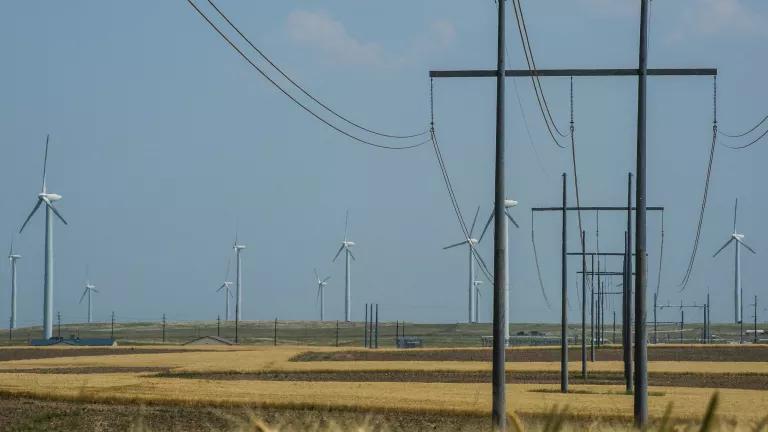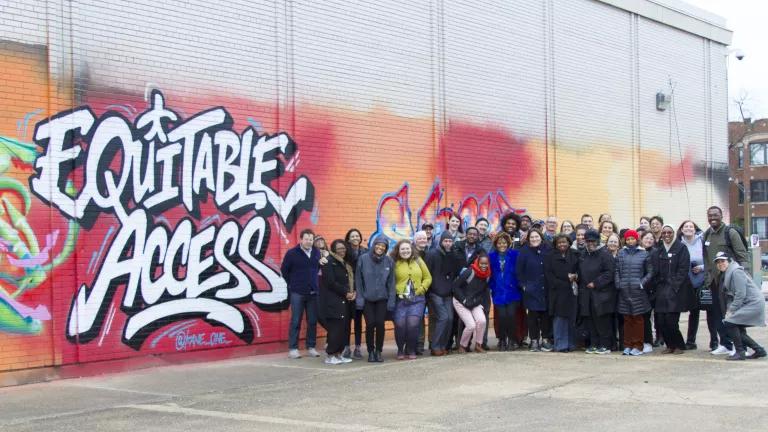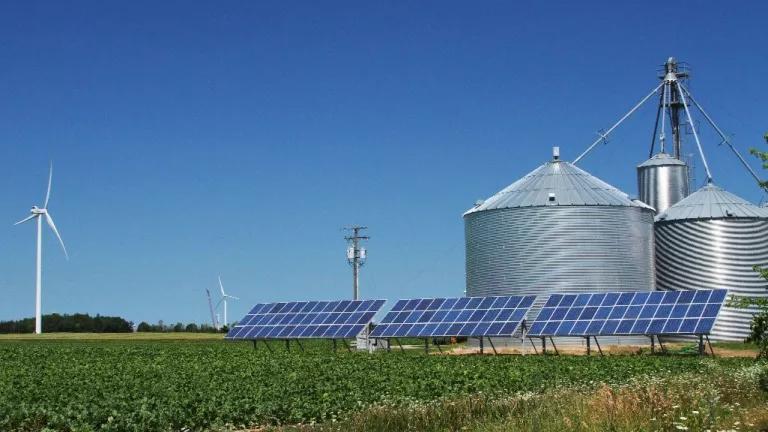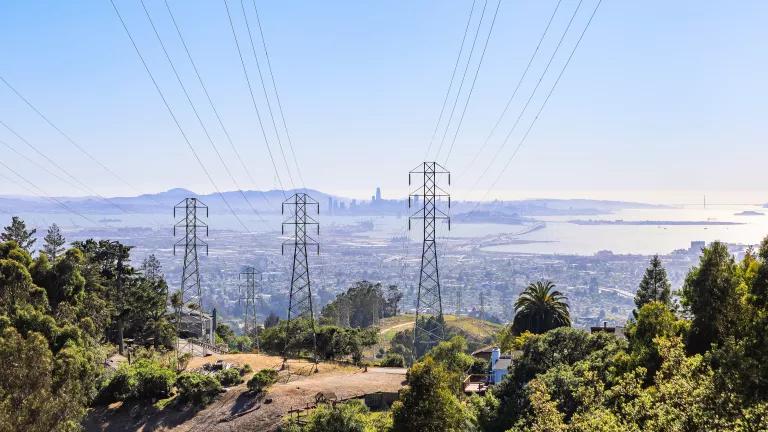Now We All Have to Be Wind, Solar, and Transmission Builders
The passage of the Inflation Reduction Act marks an unprecedented opportunity to cut greenhouse gas emissions. Clean energy advocates need to shift from working to make renewables and transmission cheaper—to making them easier to build.

July 18, 2014 - Utility scale wind turbines and transmission lines at the Cedar Creek Wind Farm in Grover, Colorado
Part of NRDC’s Year-End Series Reviewing 2022 Climate & Clean Energy Developments
With the passage of the Inflation Reduction Act (IRA), the United States has an unprecedented opportunity to dramatically cut our greenhouse gas emissions. To deliver on the promise of the IRA, by 2030, we need to increase renewable energy deployment four-fold over today’s levels. We must also double the rate at which we’re building the transmission system, focusing on larger, interstate lines instead of the small local lines that we mostly build today.
To this end, clean energy advocates need to shift from working to make renewables and transmission cheaper to working to make them easier to build. And we must do this while making sure these projects are built responsibly, dramatically increasing conservation, and helping to redress our nation's history of systemic racism and deepening inequality.
Congress should pass the EJ for All Act and it should give FERC clear authority to permit large (1,000 MW+) interstate transmission lines. NRDC and other NGOs recently released principles for transmission permitting reform. The Biden administration should leverage existing authorities to move towards a “permit one, build many” model, relying on the aggressive use of programmatic environmental impact statements. Meanwhile, states should set clearer standards for process, inclusion, wildlife protections, and how renewable energy projects can maximize community benefits.
Despite tremendous progress over the past two decades, the U.S. electricity grid remains primarily powered by fossil fuels, far from where it needs to be to achieve net-zero emissions economy-wide by 2050 and President Biden’s intermediate goal of an 80 percent clean grid by 2030.

Although the U.S. has installed 135 GW of wind capacity (12% of system) and 58 GW of utility-scale solar capacity (5% of system) as of 2021, fossil resources (coal, gas, and oil) make up 63% of capacity (676 GW)1 (Figure 1). However, this picture is rapidly changing. Wind capacity is expected to grow 60%—and solar capacity expected to nearly quadruple—as a result of planned and announced capacity additions leading up to 2027. Still, this pace is not nearly fast enough. NRDC’s analyses on pathways to net-zero GHG emissions (which will be released publicly in January) conclude solar and wind capacity must double once more by 2030 (Figure 2)2. In other words, this trajectory asks us to build at an unprecedented rate of 60 GW of solar and 40 GW of wind per year for the next decade.

The transmission system needs similar levels of buildout. Under business-as-usual projections, transmission capacity will only grow 12% by 2030 and 17% by 2040. This is not nearly enough to meet the demands of our transitioning energy system. Under NRDC’s net-zero pathway, transmission capacity doubles, then triples, then quadruples today’s levels over the next three decades. Princeton’s Jesse Jenkins recently showed that over 80% of the potential carbon emissions reductions of the Inflation Reduction Act by 2030 will be lost if transmission growth is limited to its recent growth rate.

If we miss these targets, we will be left with an exceedingly narrow range of ways to achieve net-zero, relying on riskier and more expensive pathways. For example, under NRDC’s “Constrained Renewables” scenario, we see a higher deployment of natural gas, carbon sequestration, and biofuels to meet the gap.3 If these options curb carbon at all, they will almost certainly come with major equity, public health and biodiversity costs.
The general advocacy approach for renewables has focused on making them more competitive. If renewables are the most economically attractive option, the theory goes, they will be chosen and built by the market. Money greases the wheels of change; if we had another 10 years, the money in the IRA would undoubtedly incentivize renewables permitting at all levels. After all, public dollars have been upholding the fossil fuel industry for over a century, and conventional energy infrastructure is resultingly permitted and built at an alarming clip.
Unfortunately, we have no time left to let the market work out the kinks of renewable permitting, nor do we want the clean energy industry to inherit any of the destructive and racist permitting solutions exploited by the incumbent system. Being clean energy advocate in a post-IRA world will require shifting our focus from incentives and standards to a transformation of the siting and permitting process into one that is efficient, protective, and just, from the federal level all the way down to the local level.
In 2022, advocates fought hard to keep renewables cheap for decades to come, and we largely succeeded in that respect with the IRA. Now, we have a new line of work cut out for us: let’s get building.
[1] This does not include the 37 GW of distributed (e.g., rooftop) solar on the system.
[2] This doubling is necessary to hit the 573 GW target for solar and 472 GW target for wind under NRDC’s “Core” scenario to achieve the United States’ NDC of 53% emissions reductions relative to 2005 levels by 2030.
[3] Relative to NRDC’s “Core” decarbonization scenario, which assumes solar and wind energy are only limited by their technical resource potential (and not by siting or permitting constraints).




